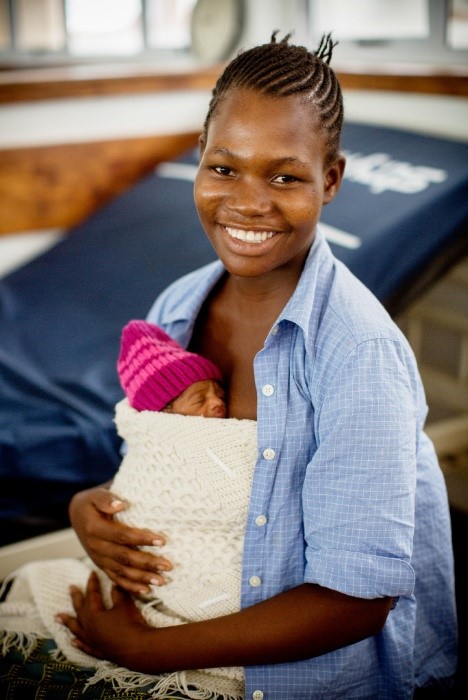Kangaroo Mother Care Space Layout and Design
 The Challenge:
The Challenge:
Over 80% of premature babies born worldwide are late-preterm, and do not require intensive care to survive and thrive(WHO, 2014). The cornerstones of essential newborn care—particularly thermal care and breastfeeding, can save these babies lives if they are implemented rigorously.
Kangaroo Mother Care, which consists of continuous skin-to-skin contact between mother and baby and exclusive breastfeeding, centers heavily around the mother and family, rather than the health provider and technology, and thus traditional health systems are not well-equipped to ensure success. Indeed, global coverage of KMC is estimated to be less than 5% for preterm babies. This low coverage is due to the fact that health facilities are not currently equipped to deliver the family-centered care preterm infants need, namely KMC.
Data supports the notion that if we are able to scale-up KMC, we will see significant reductions in newborn mortality around the globe. Recent meta-analyses show that KMC reduces:
- Neonatal mortality, decreasing deaths by 36% among low birth weight babies (Boundy, 2016).
- Neonatal infections and sepsis,
- Hypothermia for newborns,
- Lower respiratory tract disease for newborns, and
- Prolongs the period of exclusive breastfeeding, maternal-infant bonding, weight gain and improved long-term child development and health (Conde-Agudelo A, 2014).
The Purdue Innovation:
Purdue University will work with Save the Children to make the blueprint for family-centered care of preterm infants by addressing three of the leading documented health systems bottlenecks for implementation of KMC: lack of smart space, shortage of appropriately competent health workers, and lack of mobilization in the community. The blueprint will include plans for infrastructure development and behavioral interventions for healthcare providers and families.
Infrastructure:
We will design an optimal space layout/floorplan and prototype(s) for adaptable space saving furniture for the provision of family-centered KMC services in newborn care units in low-income countries. This innovation will be designed through a close collaboration between two groups of experts: key members of the KAP and Purdue’s I2D Lab.
The combined KAP and I2D team will work together to research, design and pilot a recommended space layout and floorplan for integrating KMC into newborn care units in low income countries. Additionally, we will develop a prototype for space-saving furniture pieces that can meet the seemingly contradictory needs of a newborn unit offering family-centered KMC (i.e. privacy for breastfeeding, open plan for monitoring, strict hygiene, comfortable for family, etc) During the research phase of the work, a meeting between the two groups of experts will be convened to facilitate the working relationship and planning. A pilot site will be chosen and visited by experts in system and industrial engineering and human factors to undertake a study of the “patient flow” to determine the activities and needs of the patients/mothers as well as the providers in the space. The team will work with a local development team, including a committee of local families, to understand the space considerations needed, taking into account local culture/context, as well as what is needed to sustain the potential benefits of designed facilities.
We have proved the life-saving potential of KMC, but health facilities are simply not built and equipped to deliver family-centered care for preterm infants
The end products of this innovation will include a floor plan that optimally integrates the space and materials needed for KMC into newborn care units, as well as prototypes for specialty ‘space saving’ products and furniture to make the clinic setup work, such as fold-up beds, fold-away chairs, privacy screens, and washing stations. Any space-saving products would need to be inexpensive enough to be recreated in multiple low resource countries and the aim of the floorplan would be to also develop suggested adaptations that can be made so that it can be applied to a variety of hospital settings/levels with slight modifications.
The developed space plan/floorplan and prototypes for adaptable space saving furniture can then be tested at a pilot location that is part of the KAP community of practice, with the ultimate end goal being to create optimal physical space arrangement needed to support the implementation of family-centered KMC in newborn units.
The Kangaroo Mother Care Acceleration Partnership (KAP), initiated by the Bill and Melinda Gates Foundation and led by SNL. KAP members come from diverse geographical and professional backgrounds, including researchers, clinicians, government officials, program managers, professional associations, international organizations, and non-governmental organizations.
The Partners:
- Yuehwern Yih, Purdue University. Regenstrief Center for Healthcare Engineering Faculty Scholar. Director, Smart Systems and Operations Laboratory. Professor, School of Industrial Engineering
- Steve Visser, Purdue University. Professor of Industrial Design
- Bina Valsangkar, MD, MPH, FAAP, Save the Children, Department of Global Health
- Greta Wetzel, MSW, Save the Children, Department of Global Health
